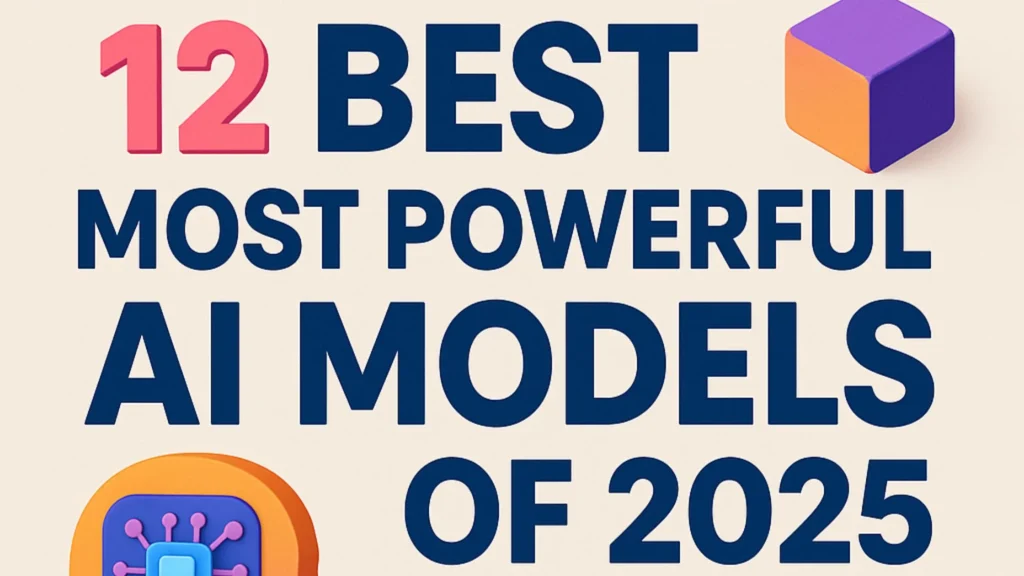Introduction
As we step deeper into the AI-driven era, 2025 is shaping up to be a groundbreaking year for artificial intelligence. From Google and OpenAI to emerging players like Cohere and Mistral, the latest AI models are not only more powerful—they are redefining how we interact with machines. In this blog post, we’ll explore the 12 most influential AI models of 2025, detailing their features, applications, and real-world impact. Whether you’re a tech enthusiast, marketer, developer, or business leader, this guide will help you stay ahead in the age of generative intelligence.
1. Google Gemini 2.5
Overview: Gemini 2.5 is the latest iteration of Google DeepMind’s multimodal model. Building upon Gemini 1.5 and Gemini 2.0 Pro, this version merges advanced reasoning, real-time web data retrieval, and multimodal processing capabilities.
Key Features:
- Seamless multimodal input: Text, images, videos, audio, and code.
- Integrated real-time search via Google.
- Strong in STEM reasoning, programming, and document analysis.
- Improved memory and context understanding over 1M tokens.
Use Cases:
- Academic research and tutoring.
- Automated customer support.
- Content generation (text + media).
- Scientific data analysis.
2. ChatGPT-4o Image Generator (OpenAI)
Overview: Launched as part of ChatGPT-4o, this advanced image generation tool from OpenAI takes multimodal prompts and turns them into stunning, context-aware visuals.
Key Features:
- Natural language to high-resolution image generation.
- Understands emotion, light, texture, and depth.
- Fast generation with photorealistic results.
- Customization for style, colors, and themes.
Use Cases:
- Visual content creation for blogs, marketing, and branding.
- Storyboarding and character design.
- E-commerce product visualization.
- Social media and ad creatives.
3. Stability AI’s Stable Virtual Camera
Overview: This innovation from Stability AI introduces a generative video tool that mimics real-time camera operations in virtual environments.
Key Features:
- Generates 3D camera angles from text and static images.
- Supports cinematic movements like panning, zooming, and tracking.
- Real-time rendering of synthetic scenes.
Use Cases:
- Filmmaking and previsualization.
- VR/AR development.
- Game design.
- Virtual influencer content creation.
4. Cohere’s Aya Vision
Overview: Aya Vision is a multimodal LLM from Cohere, expanding upon their language models with a strong emphasis on vision-language reasoning.
Key Features:
- Image-text comprehension.
- Superior fine-tuning for enterprise applications.
- On-device compatibility for privacy-first scenarios.
Use Cases:
- Retail product tagging and recommendations.
- Visual sentiment analysis.
- Secure visual AI for financial institutions.
- AI copilots for content review.
5. OpenAI’s GPT-4.5 “Orion”
Overview: GPT-4.5, codenamed “Orion,” bridges the gap between GPT-4 and the highly anticipated GPT-5. It features deeper reasoning and better reliability across long-form tasks.
Key Features:
- Expanded context window (up to 128K tokens).
- Faster inference and fewer hallucinations.
- Improved code writing, multi-turn dialogue, and decision trees.
Use Cases:
- Legal and financial document drafting.
- Technical writing and coding.
- Educational content creation.
- High-context chat assistants.
6. Claude Sonnet 3.7 (Anthropic)
Overview: Claude Sonnet 3.7 is part of Anthropic’s Constitutional AI framework. It continues to evolve in safety, instruction-following, and multimodal reasoning.
Key Features:
- Deep understanding of ethical boundaries.
- Fewer jailbreaks and bias outputs.
- Great for summarization and sensitive industries.
Use Cases:
- Healthcare and compliance content.
- Legal summarization.
- Business intelligence.
- Safe enterprise chatbots.
7. xAI’s Grok 3
Overview: Elon Musk’s xAI released Grok 3 as a powerful model directly integrated into X (formerly Twitter), merging real-time data with AI generation.
Key Features:
- Deep X-platform integration.
- Real-time cultural and social trend analysis.
- Fact-aware text generation.
Use Cases:
- Social media content creation.
- Sentiment tracking.
- Trend forecasting.
- Personalized news feeds.
8. OpenAI o3-mini
Overview: A lightweight model developed for mobile and low-latency devices, o3-mini is a distilled version of OpenAI’s core LLM architecture.
Key Features:
- Optimized for edge devices.
- Energy-efficient and fast.
- On-device privacy and low bandwidth needs.
Use Cases:
- Smart home assistants.
- Offline chatbots.
- Wearables and IoT integrations.
- Language learning apps.
9. OpenAI Deep Research
Overview: This is OpenAI’s internal research LLM used for long-form scientific exploration and automated literature reviews.
Key Features:
- Cites sources in academic formats.
- Extracts insights from large datasets.
- Custom fine-tuning on research papers.
Use Cases:
- R&D automation.
- Pharma and biotech research.
- Academic paper summarization.
- Competitive intelligence.
10. Mistral Le Chat
Overview: Le Chat is Mistral’s AI chatbot interface, powered by their open-weight models and built for transparency and open-source communities.
Key Features:
- Community-driven feedback loops.
- Based on Mixtral 8x22B and related architectures.
- Intuitive UI for code, Q&A, and creative writing.
Use Cases:
- Developer support.
- Creative writing assistant.
- Knowledge base chat.
- Open-source documentation.
11. OpenAI Operator
Overview: Operator is a tool for creating autonomous agents that can take actions based on user input or triggers.
Key Features:
- Workflow automation and integration.
- Access to APIs and tools like Zapier, databases, CRMs.
- Reactive behavior and task execution.
Use Cases:
- Virtual customer service agents.
- Auto-pilot for eCommerce tasks.
- CRM lead follow-ups.
- Dynamic scheduling and notifications.
12. Google Gemini 2.0 Pro Experimental
Overview: This Pro Experimental version of Gemini 2.0 serves as Google’s testbed for boundary-pushing AI features in research and enterprise deployment.
Key Features:
- Higher-order logic and symbolic reasoning.
- Native integration with Google Workspace.
- Early access features: agentic memory, scratchpads, and tool use.
Use Cases:
- R&D prototypes.
- AI copilots in Docs, Sheets, and Slides.
- Scientific simulations.
- Workflow optimization.
Final Thoughts
The AI landscape in 2025 reflects rapid progress across multiple vectors: vision, reasoning, generation, and autonomy. These models are not just tools—they’re co-pilots for innovation, creativity, and intelligence augmentation. Whether you’re building products, generating content, or researching breakthroughs, these 12 AI models offer a glimpse into the future of human-AI collaboration.

